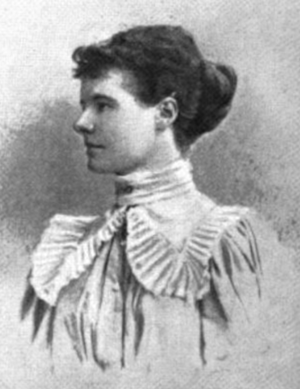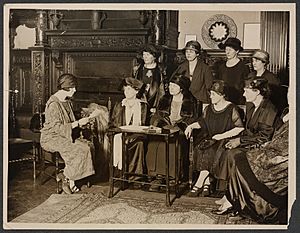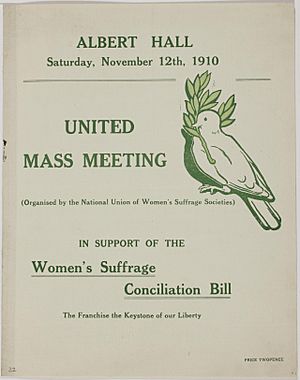Virginia Mary Crawford facts for kids
Quick facts for kids
Virginia Mary Crawford
|
|
|---|---|

In The Sketch, 15 January 1896
|
|
| Born |
Virginia Mary Smith
20 November 1862 Newcastle upon Tyne, England
|
| Died | 19 October 1948 (aged 85) Holland Park, London, England
|
| Nationality | British |
| Known for | Catholic suffragist, feminist, journalist and author |
| Movement | Catholic Women's Suffrage Society |
| Spouse(s) | Donald Crawford, divorced her citing Dilke in 1866 |
| Parents |
|
| Top - 0-9 A B C D E F G H I J K L M N O P Q R S T U V W X Y Z |
Virginia Mary Crawford (born November 20, 1862 – died October 19, 1948) was an important British writer and activist. She was a suffragist, which means she worked for women's right to vote. She was also a feminist, believing in equal rights for women. Virginia was a journalist and author, and she started the Catholic Women's Suffrage Society.
Virginia Crawford's Early Life and Career
Virginia Mary Smith was born on November 20, 1862, in Gosforth House, England. She was one of ten children of Thomas Eustace Smith, a politician and shipowner, and Martha Mary Dalrymple.
In 1881, Virginia married Donald Crawford, a Scottish politician. A few years later, she was involved in a public divorce case that caused a big scandal. This event changed her life path. She decided to move forward and become a public figure as a writer and activist.
Virginia's older sister, Margaret, helped her meet W. T. Stead, a newspaper editor. This meeting helped Virginia start her writing career. She helped other authors with their research and interviewed important people like Cardinal Manning.
In 1889, Virginia became a Catholic. She said this decision completely changed her life. She wrote many articles and books. Her writings covered topics like Italian art, French literature, and social issues. She also wrote about women's rights in the workplace. Her work was published in well-known magazines like Littell's Living Age and Dublin Review.
Role in Women's Rights Movements
Virginia Crawford was a strong supporter of women's rights. In 1897, she wrote about "Feminism," explaining that it meant working to remove unfair limits on women in society. She learned about women's rights movements in other countries like France, Belgium, Switzerland, and Italy. In 1901, she even gave a speech in French in Milan, Italy, about women's right to vote. She was the first woman to speak to a crowd in the Milan Archbishop's Palace grounds.
In Britain, Catholics were a smaller group. Virginia believed that Catholic women should not just watch politics from the sidelines. She thought that Christian faith and working for women's right to vote went together. Many men, including some church leaders, disagreed with her.
Virginia knew that to win voting rights, Catholic women needed to work with other groups. These included the Women's Social and Political Union (WSPU) and the National Union of Women's Suffrage Societies. Another Catholic feminist, Charlotte Despard, even joined a WSPU protest that led to her arrest.
Virginia helped organize the 1910 Women's March in London. Thousands of women marched peacefully to the Albert Hall. In 1911, Virginia and a small group of Catholic women started the Catholic Women's Suffrage Society (CWSS). Their goal was to get equal voting rights for men and women. They also wanted to improve the difficult working conditions for millions of working women.
Some people thought that asking for votes for women was against religious beliefs. But Virginia disagreed. The CWSS worked with other suffrage groups, but they did not support violent protests. Some Catholic activists, like Alice Abadam, encouraged church women to join the suffrage movement. They believed it could help improve the lives of many poor women.
On June 17, 1911, during the Coronation Procession, about eighty CWSS members marched. They wore religious medals and some prayed as they walked. People watching cheered for them.

When the Representation of the People Act 1918 gave some women the right to vote, the CWSS held a special church service to celebrate. But they kept working for more rights, like equal pay for equal work and voting rights for all women.
In 1926, the CWSS joined the International Alliance of Women. They changed their name to St. Joan's Social and Political Alliance. Virginia Crawford became its first leader. She pushed for women over 21 to have the same voting rights as men. When all women finally got equal voting rights, the St. Joan's Alliance held another thanksgiving service. They also had a procession that included both Catholic and Protestant suffragists.
Even in her sixties, Virginia continued her work. She traveled to Paris to meet with Catholic suffragists from other countries. The organization also had groups in Scotland, Ireland, and Croatia. Virginia and the St. Joan's Alliance worked to help women's rights around the world.
Virginia also led the St. Joseph's Home for Girl Mothers. She helped start the Catholic Social Guild. For thirty years, she served on the Board of Guardians, helping people in need. After the First World War, she was an elected councillor for Marylebone for fourteen years.
Death and Legacy
Virginia Crawford passed away in Holland Park, London, on October 19, 1948. The charitable groups she helped start still exist today. Her writings are also still being reprinted and read.



